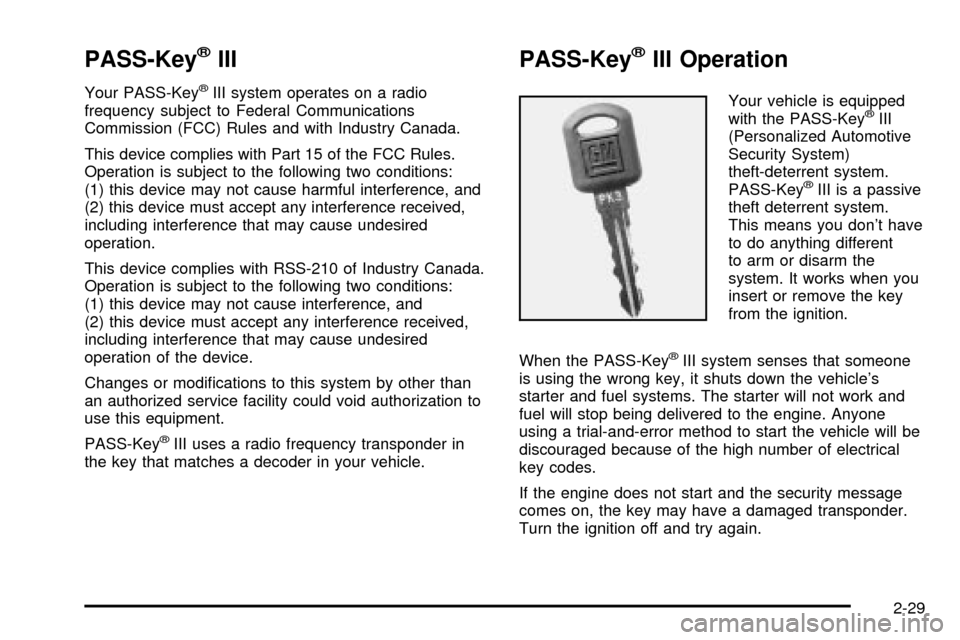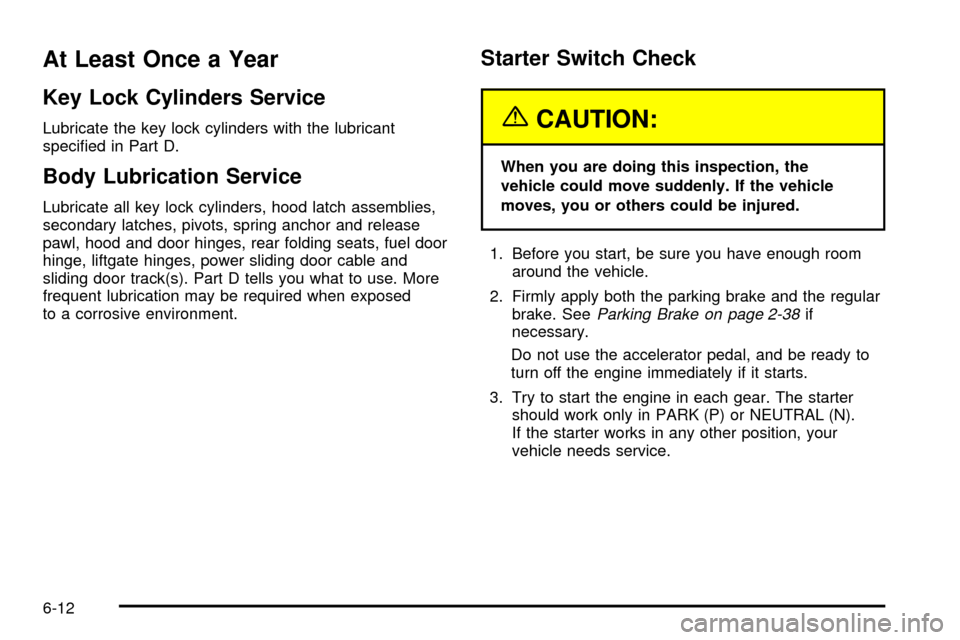2003 CHEVROLET VENTURE starter
[x] Cancel search: starterPage 139 of 486

PASS-KeyžIII
Your PASS-KeyžIII system operates on a radio
frequency subject to Federal Communications
Commission (FCC) Rules and with Industry Canada.
This device complies with Part 15 of the FCC Rules.
Operation is subject to the following two conditions:
(1) this device may not cause harmful interference, and
(2) this device must accept any interference received,
including interference that may cause undesired
operation.
This device complies with RSS-210 of Industry Canada.
Operation is subject to the following two conditions:
(1) this device may not cause interference, and
(2) this device must accept any interference received,
including interference that may cause undesired
operation of the device.
Changes or modi®cations to this system by other than
an authorized service facility could void authorization to
use this equipment.
PASS-Key
žIII uses a radio frequency transponder in
the key that matches a decoder in your vehicle.
PASS-KeyžIII Operation
Your vehicle is equipped
with the PASS-KeyžIII
(Personalized Automotive
Security System)
theft-deterrent system.
PASS-Key
žIII is a passive
theft deterrent system.
This means you don't have
to do anything different
to arm or disarm the
system. It works when you
insert or remove the key
from the ignition.
When the PASS-Key
žIII system senses that someone
is using the wrong key, it shuts down the vehicle's
starter and fuel systems. The starter will not work and
fuel will stop being delivered to the engine. Anyone
using a trial-and-error method to start the vehicle will be
discouraged because of the high number of electrical
key codes.
If the engine does not start and the security message
comes on, the key may have a damaged transponder.
Turn the ignition off and try again.
2-29
Page 143 of 486

Notice:Holding your key in START for longer than
15 seconds at a time will cause your battery to
be drained much sooner. And the excessive heat
can damage your starter motor. Wait about
15 seconds between each try to help avoid draining
your battery or damaging your starter.
2. If the engine doesn't start in 10 seconds, push the
accelerator pedal about one-quarter of the way
down while you turn the key to START. Do this until
the engine starts. As soon as it does, let go of
the key.
3. If your engine still won't start (or starts but then
stops), it could be ¯ooded with too much gasoline.
Try pushing your accelerator pedal all the way to the
¯oor and holding it there as you hold the key in
START for a maximum of 15 seconds. This clears
the extra gasoline from the engine. If the engine
still won't start or starts brie¯y but then stops again,
repeat Step 1 or 2, depending on the temperature.
When the engine starts, release the key and
the accelerator pedal.
Notice:Your engine is designed to work with the
electronics in your vehicle. If you add electrical
parts or accessories, you could change the way the
engine operates. Before adding electrical equipment,
check with your dealer. If you do not, your engine
might not perform properly.
Engine Coolant Heater
Your vehicle may have an engine coolant heater. In
very cold weather, 0ÉF (-18ÉC) or colder, the engine
coolant heater can help. You'll get easier starting
and better fuel economy during engine warm-up.
Usually, the coolant heater should be plugged in a
minimum of four hours prior to starting your vehicle. At
temperatures above 32ÉF (0ÉC), use of the coolant
heater is not required.
2-33
Page 446 of 486

At Least Once a Year
Key Lock Cylinders Service
Lubricate the key lock cylinders with the lubricant
speci®ed in Part D.
Body Lubrication Service
Lubricate all key lock cylinders, hood latch assemblies,
secondary latches, pivots, spring anchor and release
pawl, hood and door hinges, rear folding seats, fuel door
hinge, liftgate hinges, power sliding door cable and
sliding door track(s). Part D tells you what to use. More
frequent lubrication may be required when exposed
to a corrosive environment.
Starter Switch Check
{CAUTION:
When you are doing this inspection, the
vehicle could move suddenly. If the vehicle
moves, you or others could be injured.
1. Before you start, be sure you have enough room
around the vehicle.
2. Firmly apply both the parking brake and the regular
brake. See
Parking Brake on page 2-38if
necessary.
Do not use the accelerator pedal, and be ready to
turn off the engine immediately if it starts.
3. Try to start the engine in each gear. The starter
should work only in PARK (P) or NEUTRAL (N).
If the starter works in any other position, your
vehicle needs service.
6-12
Page 483 of 486

Service (cont.)
Doing Your Own Work................................... 5-3
Engine Soon Light.......................................3-45
Publications Ordering Information...................7-10
Traction System Warning Message.................3-50
Setting Preset PTYs........................................3-86
Setting Preset Stations............3-63, 3-66, 3-73, 3-83
Setting the Temperature...........................3-30, 3-32
Setting the Time.............................................3-61
Radios with Radio Data Systems (RDS).........3-61
Radios without Radio Data Systems (RDS).....3-61
Setting the Tone
(Bass/Treble)......................3-63, 3-66, 3-74, 3-83
Sheet Metal Damage.......................................5-93
Shifting Into Park (P).......................................2-39
Shifting Out of Park (P)...................................2-41
Shoulder Belt Height Adjuster...........................1-38
Side Window Latches......................................2-25
Skidding........................................................4-14
Sliding Door Delayed Locking...........................2-13
Sliding Door Lock...........................................2-14
Sliding Door, Power........................................2-17
Sliding Door Security Lock...............................2-15
Sliding Doors, Dual.........................................2-13
Some Other Rainy Weather Tips.......................4-19
Spare Tire Check............................................6-11
Special Fabric Cleaning Problems.....................5-88
Speci®cations, Capacities...............................5-103
Speedometer..................................................3-38Split Bench Seats............................................. 1-8
Starter Switch Check.......................................6-12
Starting Your Engine.......................................2-32
Steering in Emergencies..................................4-11
Steering, Suspension and Front Drive Axle
Boot and Seal Inspection..............................6-15
Steering Tips..................................................4-10
Steering........................................................4-10
Stereo RCA Jacks..........................................3-94
Storage Areas................................................2-51
Compact Overhead Console..........................2-52
Convenience Center.....................................2-58
Convenience Net.........................................2-57
Cupholder(s)...............................................2-51
Front Seat Storage Net................................2-54
Glove Box..................................................2-51
Luggage Carrier..........................................2-55
Overhead Console.......................................2-52
Rear Storage Area.......................................2-57
Storing a Flat or Spare Tire and Tools...............5-82
Storing the Built-In Child Restraint.....................1-91
Storing the Spare Tire and Tools.......................5-83
Stowable Seat................................................1-26
Stuck in Sand, Mud, Ice or Snow......................4-30
Sun Visors.....................................................2-26
Switchbanks, Instrument Panel..........................3-21
Switchbanks...................................................3-20
Overhead Console.......................................3-21
15